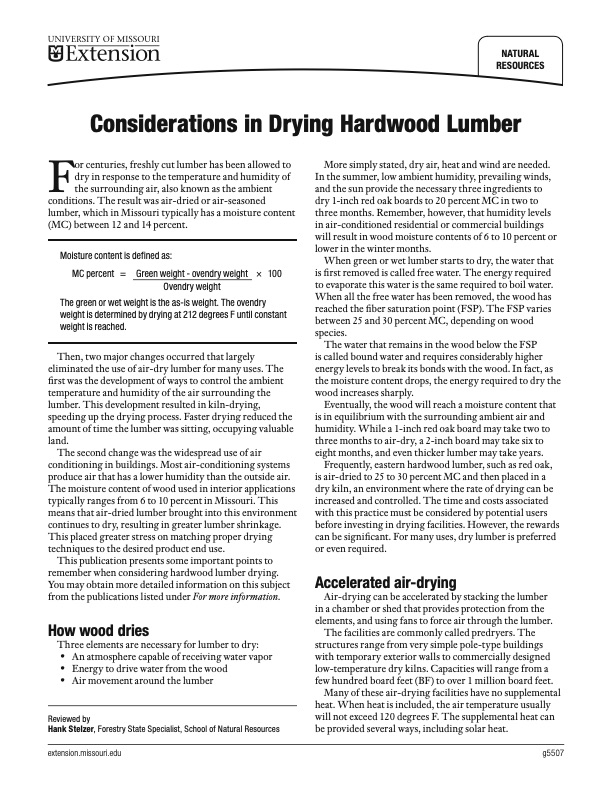
PDF Publication Title:
Text from PDF Page: 001
■ ������ �� ����������� �� ��� ����������� ��������� ���� ���� �� ��� � ��� ���� ��� ����� �� ����������� ���� ��� ������ ������ ���������� �� ������������ ��������� ����������� ���������� ���������� �� ��������� ��������� �� ����� ■ �� ����� ��������������� ����������� ■ ������������ ■ ���������������������� NATURAL RESOURCES Considerations in Drying Hardwood Lumber For centuries, freshly cut lumber has been allowed to dry in response to the temperature and humidity of the surrounding air, also known as the ambient conditions. The result was air-dried or air-seasoned lumber, which in Missouri typically has a moisture content (MC) between 12 and 14 percent. More simply stated, dry air, heat and wind are needed. In the summer, low ambient humidity, prevailing winds, and the sun provide the necessary three ingredients to dry 1-inch red oak boards to 20 percent MC in two to three months. Remember, however, that humidity levels in air-conditioned residential or commercial buildings will result in wood moisture contents of 6 to 10 percent or lower in the winter months. When green or wet lumber starts to dry, the water that is first removed is called free water. The energy required to evaporate this water is the same required to boil water. When all the free water has been removed, the wood has reached the fiber saturation point (FSP). The FSP varies between 25 and 30 percent MC, depending on wood species. The water that remains in the wood below the FSP is called bound water and requires considerably higher energy levels to break its bonds with the wood. In fact, as the moisture content drops, the energy required to dry the wood increases sharply. Eventually, the wood will reach a moisture content that is in equilibrium with the surrounding ambient air and humidity. While a 1-inch red oak board may take two to three months to air-dry, a 2-inch board may take six to eight months, and even thicker lumber may take years. Frequently, eastern hardwood lumber, such as red oak, is air-dried to 25 to 30 percent MC and then placed in a dry kiln, an environment where the rate of drying can be increased and controlled. The time and costs associated with this practice must be considered by potential users before investing in drying facilities. However, the rewards can be significant. For many uses, dry lumber is preferred or even required. Accelerated air-drying Air-drying can be accelerated by stacking the lumber in a chamber or shed that provides protection from the elements, and using fans to force air through the lumber. The facilities are commonly called predryers. The structures range from very simple pole-type buildings with temporary exterior walls to commercially designed low-temperature dry kilns. Capacities will range from a few hundred board feet (BF) to over 1 million board feet. Many of these air-drying facilities have no supplemental heat. When heat is included, the air temperature usually will not exceed 120 degrees F. The supplemental heat can be provided several ways, including solar heat. Moisture content is defined as: MC percent = Green weight - ovendry weight Ovendry weight × 100 The green or wet weight is the as-is weight. The ovendry weight is determined by drying at 212 degrees F until constant weight is reached. Then, two major changes occurred that largely eliminated the use of air-dry lumber for many uses. The first was the development of ways to control the ambient temperature and humidity of the air surrounding the lumber. This development resulted in kiln-drying, speeding up the drying process. Faster drying reduced the amount of time the lumber was sitting, occupying valuable land. The second change was the widespread use of air conditioning in buildings. Most air-conditioning systems produce air that has a lower humidity than the outside air. The moisture content of wood used in interior applications typically ranges from 6 to 10 percent in Missouri. This means that air-dried lumber brought into this environment continues to dry, resulting in greater lumber shrinkage. This placed greater stress on matching proper drying techniques to the desired product end use. This publication presents some important points to remember when considering hardwood lumber drying. You may obtain more detailed information on this subject from the publications listed under For more information. How wood dries Three elements are necessary for lumber to dry: • An atmosphere capable of receiving water vapor • Energy to drive water from the wood • Air movement around the lumber Reviewed by Hank Stelzer, Forestry State Specialist, School of Natural Resources extension.missouri.edu g5507PDF Image | Considerations in Drying Hardwood Lumber

PDF Search Title:
Considerations in Drying Hardwood LumberOriginal File Name Searched:
g05507.pdfDIY PDF Search: Google It | Yahoo | Bing
5,000 BF Shipping Container Lumber Dry Kiln For Quality Lumber The 5,000 BF container kiln consists of one 40 foot high-cube aluminum shipping container... More Info
Shipping Container Lumber Dry Kilns by Global Energy Global Energy designed and developed the container kiln back in 1991. The purpose is to give access to portable sawmill owners, furniture makers, and small business the value added profit of dry kiln lumber and quality hardwoods... More Info
Vacuum Kiln Conversion Kit for Lumber and Wood Dry Kilns Convert your existing conventional dry kiln into a fast drying vacuum kiln. Similar to vacuum bagging in the boat building and aircraft industry, we have come up with a proprietary process which allows you to build a very simple vacuum kiln at a fraction of the price, and without the intensive conventional metal chamber structure... More Info
Vacuum Pump Cart System for Bagging Clamping Wood Drying and more Vacuum Cart with 2HP Pump and Dual Pistons with multiple multiplex vacuum ports and liquid reservoir... More Info
Vacuum Bagging Basics Vacuum bagging is a method of clamping, which has traditionally been used in the composites industry, but can also be used for vacuum drying materials, including wood products... More Info
| CONTACT TEL: 608-238-6001 Email: greg@globalmicroturbine.com | RSS | AMP |